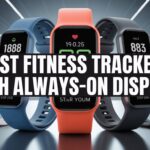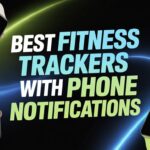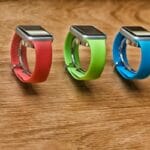Getting fit used to mean staring at a wristwatch, counting heartbeats, and hoping you’d find your way back home after a jog. Now, fitness trackers with GPS handle the hard work for us.
These gadgets track how far we run, walk, or cycle, and then show us the exact route. No more guessing or asking that neighbor who’s always outside, “just how far is it to the end of the block?”
Fitness trackers with GPS keep up with our steps, measure our heart rate, and sometimes even remind us we’re overdue for a nap. They sync with our phones, send friendly nudges to move, and can be a lifesaver for anyone who wants to see their progress mapped out.
Of course, there’s a ton of choices, and not all trackers are created equal.
When you’re looking for a GPS fitness tracker, the biggest things to watch are battery life, tracking accuracy, comfort, and how easy it is to actually use. Features like water resistance, screen size, and app compatibility matter too—unless you love squinting at tiny fonts or skipping laps in the pool by accident.
We tried out a bunch of popular trackers (so you don’t have to), and here’s what we found.
Best Fitness Trackers with GPS
We all know we should move more, but sometimes our memory is as spotty as our mapping skills. That’s where fitness trackers with GPS come in.
Let’s check out the best ones before we “forget” to count our steps again!
Amazfit Active 2 Smart Watch
If you want something stylish, practical, and way less likely to judge you for taking the elevator, the Amazfit Active 2 might be your new wrist buddy.
Pros
- Fashionable design that looks good at yoga or in the office
- Battery life that outlasts most of us
- Free offline maps with actual turn-by-turn directions
Cons
- Zepp OS takes a little getting used to
- Voice control can be moody on busy Wi-Fi
- Some features only work with Android
Unboxing this watch felt almost as exciting as the first five minutes of a HIIT class. The screen is super bright, so you don’t need to shade your wrist from the sun anymore.
When we walked into a meeting, it actually looked sharp enough to pass as jewelry—if only our running shoes could keep up.
Testing the GPS turned our Saturday hike into a low-stakes treasure hunt. The map gave us each turn straight to our Bluetooth headphones, saving us from getting lost while trying to look cool.
Heart rates and sleep hours seemed spot-on. We even used it for that new workout class that sounded more like a Pokémon than a sport.
Zepp OS is a little different, so we had to do some menu digging before finding our groove. Android users get more voice control perks, but almost everything worked on both iPhone and Android.
The battery lasted so long we forgot where the charger was—seriously, that never happens. If you want something that does more than count steps and actually looks good, the Amazfit Active 2 stands out.
Fitbit Versa 4 Smartwatch
If you want a fitness tracker that acts like it runs your life, the Versa 4 is just bossy enough for the job.
Pros
- Built-in GPS tracks runs and bike rides without needing your phone
- Battery lasts longer than our self-control with snacks
- Tons of exercise and health tracking modes
Cons
- Some features need a paid subscription (because nothing is really free)
- Can get a bit naggy about moving if you just want to lounge
- The touchscreen sometimes ignores us—rude
Strapping on the Versa 4 feels almost like bringing a personal trainer along—if that trainer loved data and never slept. We head out for a walk or jog, and its built-in GPS tracks our route exactly.
It’s a relief not dragging our phones everywhere, and the distance stats don’t lie (even when we wish they did).
We like that it lets us answer calls and read texts right from our wrist, even if it’s not always the smoothest. The workout modes cover almost anything we try, from yoga to a pretty optimistic HIIT session.
Battery life is impressive. We usually go almost a week before the charger starts staring at us accusingly.
But some of the “fancy” extras need a premium membership. A few screens felt a little slow to respond, which gets annoying if you’re in a hurry (or just impatient).
Still, for tracking health, sleep, and a million types of workouts, it’s hard to complain too much. Plus, it looks sharp enough that we might just wear it even when we’re not exercising.
Fitbit Charge 6 Fitness Tracker
If you’re looking for a no-fuss fitness tracker that nails GPS and throws in Google apps for good measure, the Fitbit Charge 6 hits the mark without emptying your wallet.
Pros
- Links straight to favorite exercise machines for live heart rate
- Built-in Google Maps makes running without getting lost almost too easy
- Touchless payment means one less excuse to stop for snacks
Cons
- Touchscreen can be stubborn with sweaty fingers
- Not every Google service works everywhere (guess we’re not moving to Mars yet)
- Band durability isn’t top tier if you treat gadgets rough
Honestly, if you’re on team “forget your phone at home but want your run tracked,” the Charge 6 has you covered. The built-in GPS stayed accurate when we sprinted to catch the ice cream truck, and Google Maps helped us remember which way to head home.
This tracker also auto-detected our workout even when our motivation was questionable.
Paying with your wrist after a workout is just plain satisfying—no more digging for cards behind someone buying twenty lottery tickets. For music, switching tracks with YouTube Music was a nice bonus.
The touchscreen sometimes hesitated with sweaty hands, but honestly, that’s probably its way of telling us to wipe down.
Swapping out bands to match our mood was easy. Fitbit has come a long way here, but if you’re rough on your gadgets, keep an extra band handy.
The Fitbit Charge 6 makes routines a bit smarter and more fun—and if we can avoid getting lost on a jog, all the better.
Amazfit GTR Mini
If you want GPS tracking without feeling chained to a charger every night, the Amazfit GTR Mini lets you roam.
Pros
- GPS always seems to know where you are—even if you’re just wandering the grocery store lost
- Survived a whole vacation without hunting for an outlet, thanks to marathon-worthy battery life
- Covers all our weird sports obsessions, even if “speed walking to the fridge” isn’t listed
Cons
- Bluetooth phone calls aren’t available, so no pretending to be a super spy
- Sometimes the app acts fussy and takes a few tries to sync
- Small watch size might feel dainty if your wrists are more “lumberjack” than “pixie”
Setting up this watch on our phones felt less like tech support and more like making a new friend—though we still squinted at instructions once or twice. Tracking runs, walks, and random sprints to the bus stop felt precise and easy.
The GPS locks on even when we zigzag like we’re in a low-budget action movie.
The best part? We actually used it without charging every night. Some of us even made it two weeks before worrying about battery—and honestly, we forgot where the charger was.
Sleep tracking gives more insight into our questionable bedtime choices. Checking stress levels might make us more stressed, but at least we know.
We dove in the pool, got caught in the rain, and pushed our luck with dishwashing—all without worry thanks to sturdy water resistance. We can’t call our mom from our wrist, but we still get polite nudges about calls and texts.
If all you need is solid GPS and reliable fitness features in a lightweight package, the Amazfit GTR Mini is tough to beat.
Amazfit Bip 5 Watch
If you want a GPS fitness tracker that won’t empty your wallet or die faster than your motivation to jog, this one should be at the top of your list.
Pros
- Bright, roomy display is easy to read, even when you’re sweating buckets
- GPS works reliably so you don’t get hilariously lost on morning walks
- Battery hangs on longer than we do during cardio day
Cons
- Notifications can get a bit too enthusiastic (do we really need a reminder for everything?)
- Band feels basic and isn’t the plushest on the wrist
- Some features hide behind fiddly menus that might test your patience
We took the Amazfit Bip 5 for a spin, and honestly, it kept up better than any of us did on the group run. That big display is bright, colorful, and easy to swipe—even with post-workout fingers.
The built-in GPS meant we only got ourselves lost once, and that was absolutely user error.
The battery life is our favorite part. It kept on trucking for days, so charging didn’t feel like a part-time job.
The health tracking features gave us solid stats on sleep, heart rate, and even stress—because sometimes tracking our stress reminds us why we’re running in the first place.
It’s not all perfect, though. We laughed at how many times it pinged us for reminders or notifications we didn’t need. Scrolling through menus felt like a mini-game (and not the fun kind).
Still, for a no-nonsense, wallet-friendly tracker with solid GPS and long battery, we’d say this watch earns its spot on our wrist—and in our group text chats.
Fitbit Inspire 3
This tracker really works if you want a simple, comfy way to track your health and hit those step goals—without frying your brain (or your wrist).
Pros
- Tracks heart rate and sleep with surprising detail for such a tiny gadget
- Lightweight design basically disappears on your wrist (until it buzzes—yep, those reminders)
- Battery lasts so long you might forget where you put the charger
Cons
- Needs your phone nearby for GPS; it’s not a lone wolf
- Screen is pretty small, so get ready to squint during sprints
- Can’t handle voice calls—no “Bond villain” moments here
Wearing the Fitbit Inspire 3 feels like your old health teacher quietly rooting for you, never yelling across the gym. I started snooping on my sleep patterns and got a little obsessed with that heart rate chart.
The band is so light, I’d forget it was there—until it buzzed and told me to stop being a couch potato.
Tracking walks and runs with GPS means dragging your phone along, which isn’t ideal, but you still get solid maps and real-time stats. Those motivational vibrations during workouts actually helped on days when I’d rather nap than count steps.
Ten days between charges? That’s wild. I almost lost the charger but didn’t even care.
If you want to answer calls from your wrist or show off a massive, flashy screen, this isn’t it. But if you’re just after fitness tracking, sleep tips, and a gentle nudge to get up (with no wrist strain), the Inspire 3 honestly impressed me for its price and size.
Garmin Forerunner 55 GPS Tracker
If you want a reliable GPS tracker but don’t want to lug around a tech brick, this is a solid bet.
Pros
- Battery life feels endless compared to most smartwatches
- Super easy to use—even if you forget what every button does
- Tracks runs, HIIT, and even how much you’re panting during breathwork
Cons
- Watch face looks small on bigger wrists
- Display isn’t exactly dazzling—might have to squint
- No touchscreen, so it’s all about those old-school buttons
When I strapped on the Garmin Forerunner 55, it felt like it belonged on my wrist—not like I borrowed my big brother’s watch. GPS locked in fast, and all I had to do was start running (which, let’s be real, is the hard part).
The battery lasted so long I actually forgot where the charger was by week two.
Daily workout suggestions saved me from doom-scrolling “how not to overtrain.” There’s enough detail for stat nerds, but it doesn’t drown you if you just want to know how far you shuffled.
I liked tracking different activities—cycling, breathing exercises, or just calling arm-flailing HIIT.
No touchscreen means more button-mashing, but hey, no sweaty touchscreen drama. It’s not the biggest or flashiest watch out there, but my wrist and wallet both felt pretty good about it.
If you want straightforward GPS tracking and solid battery life, the Forerunner is worth a look.
Amazfit Bip 6 Fitness Tracker
If you need a GPS fitness tracker that doesn’t quit after one workout and doesn’t look like a clunky calculator, this one fits the bill.
Pros
- Battery life just keeps going, even with all tracking on
- Bright, easy-to-read screen that shows off your step count like a trophy
- More exercise modes than you’ll ever actually try
Cons
- Charger is tiny and easy to lose if you’re as messy as I am
- Wristband is comfy, but taking it off to charge gets old
- Built-in apps aren’t as advanced as pricier watches
Right from the first charge, I noticed the Amazfit Bip 6 clings to power like a toddler with a cookie. I made it almost two weeks before hunting for the charger, which is good, because finding that tiny thing is a workout.
The display looks just as lively at noon in the sun as it does in bed at midnight.
Switching workout modes is smooth, and honestly, there are more options than I’ll ever use. Anyone actually tried HYROX Race mode, or is that just for show?
I liked downloading maps and grabbing GPS routes before heading out, so I only got lost twice (which is an improvement).
Missing a text or call is nearly impossible with those wrist buzzes. Health stats update in real time, so now I check my pulse every time the neighbor’s dog barks.
The biggest hassle is wrestling the wristband for charging, but for this mix of smart features and fitness cred, I’m willing to deal with it.
Garmin vívoactive 5
If you want a GPS fitness watch that keeps up with your steps—and your naps—this is the one to try.
Pros
- Bright display is easy to see, even if you forget your glasses
- Battery actually lasts almost two weeks, so you don’t panic when the charger disappears
- Tons of health features help you pretend you’re an organized adult
Cons
- Touchscreen can get sluggish after a sweaty workout
- Some features hide behind confusing settings
- Watch isn’t totally waterproof, so no diving
When I first put this watch on, I noticed how light and comfortable it felt. The display is so bright I could spot a text in the middle of a workout or under a blazing sun.
I wore it all day and overnight, and it never dug into my wrist like some chunkier models.
The battery life is the real win. My last watch basically lived on the charger, but this one lasted over a week without drama.
That means I finally used sleep tracking for more than just one night. I got helpful info about stress, daily activity, and even reminders to relax—apparently, I’m a secret stress monster.
On the downside, the settings and menus confused me at first. I had to poke around to get GPS tracking to work the way I wanted.
Plus, I almost took it for a swim but stopped myself—turns out, it’s only water resistant, not for deep dives.
If you want lots of health stats, smart notifications, music, and a display that doesn’t quit, the vívoactive 5 is easy to recommend—just don’t expect it to do your chores.
Amazfit Bip 3 Pro
If you want to get moving and double your step count without draining your bank account (or your patience with charging), this watch is a smart choice.
Pros
- Runs for almost two weeks on a single charge
- GPS is accurate and keeps your routes on track
- Comfortable band that feels barely there
Cons
- Syncing with the app takes some patience
- Watch faces are a bit underwhelming
- Disconnects from phones every now and then
Honestly, nobody wants to recharge another gadget every night, so the Bip 3 Pro’s battery life feels like magic. I used it for days and forgot where I left the charging cable.
GPS tracking is sharp and matches my real-life jogging detours almost step for step. The silicone strap is soft enough that I didn’t notice it during sleep tracking—or when I dozed on the couch.
Switching between sports modes is easy, but losing patience with the watch faces is just as easy. Not many fun options, and some look like jokes.
The watch likes to randomly lose connection to my phone, which could be my device… or maybe it’s just moody.
Despite some syncing weirdness, everyday use is smooth. Sleep tracking, heart rate stats, and water resistance for sweaty runs or cannonballs make the Bip 3 Pro a handy daily buddy.
For the price, it feels like a good deal—just expect a few quirks along the way.
Buying Guide
When we’re looking for a fitness tracker with GPS, we want something that’ll track our sprints—not just our grocery runs.
Honestly, who wants to turn their wrist into a mini computer? Let’s focus on what actually helps us move.
First up, here’s a quick table:
| Feature | Why It Matters |
|---|---|
| GPS Accuracy | For reliable distance tracking |
| Battery Life | Nobody wants to charge every day |
| Water Resistance | Survives sweat and rain |
| Comfort | No one likes itchy wrists |
| Display | Easy to read under the sun |
Grab a tracker with built-in GPS if you want to leave your phone at home and still map your morning jogs.
If you’re always glued to your phone anyway, connected GPS probably works fine.
Comfort really matters. If the band pinches or leaves a rash, it’s going to end up in a drawer—right next to that jump rope you swore you’d use.
Try adjustable straps or go for softer materials.
Let’s talk about battery life. Some trackers last a whole week, while others barely make it through the day.
Nobody wants their battery dying halfway through a hike. We need a tracker with enough stamina to keep up—or at least to match our ambition.
Water resistance comes in handy if you sweat a lot or want to pretend you swim laps.
Readable displays matter too, whether you’re running in the sun or sneaking a peek at notifications during a boring meeting.
Really, pick features that fit your activity level and comfort needs—not just the shiny extras you’ll never use.
- Why is my fitness tracker not pairing with Apple Health? Troubleshooting for Technologically Cursed Mortals - December 22, 2025
- Why is my fitness tracker not updating firmware? Tech Tantrums and Update Woes Explained - December 21, 2025
- Why is the Sound Quality on My Bluetooth Headphones Poor? It’s Not Just Bad Music Taste! - December 21, 2025
















